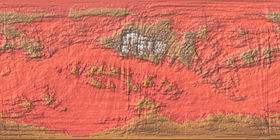Amara
| Amar | |
|---|---|
 Imperial Armoury World | |
|
Segmentum: |
Ultima Segmentum |
|
Sector: |
|
|
Subsector: |
|
|
System: |
|
|
Class: |
Armoury World |
|
Type: |
Minor |
 ' | |
Contents
Geography
Physics
Type Small iron/silicate
Mass 7.32 x 1823 kg
Density 8.94 g/cm3
Composition 50.9% iron, 19.2% silicon, 18.8% calcium, 3.5% magnesium, 3.2% other metals, 4.4% other elements |style="width: 33%;"|
Gravimetry
Gravity 4.70 m/s2
Escape Velocity 7.81 km/s
Rotation Period 13.4 hours
Axis Tilt 40.81 ° |style="width: 33%;"|
Atmosphere
Type Slight Toxic Breathable
Pressure 775.64 kPa
Composition 77.1% Nitrogen, 20.9% Oxygen, trace other gases |}
Summary
Amara is a Departmento Munitorum Armoury world. A vast storage facility for supplies and equipment mothballed for use by newly raised Expiditenary Fleets and as emergency war reserves.
Population
Approximately 23 million people
Society
History
Imperial records do not detail the early colonisation of Amara. It is most likely that the planet was discovered by humans during the early years of the Dark Age of Technology. No records specifically refer to the Varangian system, but it is known that many star systems on the Eastern Fringes of the galaxy were first being explored at this time. On first discovery Amara must have been a dead world, bereft of any life, a hot desert planet of sand and rock with an unbreathable atmosphere of reducing gases. If life ever tried to evolve on Amara, it never progressed beyond the level of microorganisms. The planet had no liquid ground water and very little atmospheric moisture. The atmosphere was not breathable for humans and the environment was too harsh to foster life. But early human explorers must have noted that although lifeless now, the planet's ecosystem was not far from being life-sustaining. Temperatures were high (in the deep deserts very high) but not to the point of making the world uninhabitable. There was some atmospheric moisture and better still; the planet was extremely rich in strategic metals. Huge quantities of useful ores were present and much of it was close to the surface and easily accessible to strip-mining techniques. There was a stable atmosphere which could be manipulated. Amara was not beyond hope for human colonisation. The lure of the ore deposits made the planet a viable prospect for terraforming.
During the Dark Age of Technology, Mankind had both the advanced technology and knowledge required to alter planetary atmospheres and ecosystems to create a habitat conducive to human life. The transformation did not have to be extensive, only creating a climate where a colonist could survive without an environmental suit and dig a mine. Aided by long-forgotten advanced technology, these human explorers set about terraforming the lifeless desert world into something humanity could survive upon. It did not happen overnight. It may well have taken as long as 5,000 Terran years of hard work, but liquid water was eventually introduced to the planet's surface in the form of artificial seas. Genetically engineered plants and algae were also introduced to the Amara ecosystem, creating a breathable oxygen atmosphere in time. Careful management and nurturing slowly changed the atmosphere. How this was done is a mystery in the less technically sophisticated Age of the Imperium, but some life now exists on Amara. The first mention of Amara in Imperial records is in the 30th Millennium, just after the end of the Age of Strife. The planet was rediscovered by the armies of the newborn Imperium's Great Crusade as they spread out from Earth, reconquering the Milky Way Galaxy for Mankind and reuniting the scattered human colony worlds that had long been sundered from one another by Warp Storms and wars. Humanity had barely survived on Amara, degenerating into a savage, Stone Age tribal existence. The population, probably never large, had dwindled to less than one million people. In another thousand years, human life on the planet would have been extinct.
Rediscovery of the planet's mineral wealth resulted in the Imperium deciding to recolonise Amaras. The regressed and now hostile colonists were exterminated by one of the Great Crusade's Expeditionary Fleets and new Imperial colonists moved in, establishing mining stations and a spaceport. Over the next years of the Imperium's rule, Lincon Secondus's population steadily grew to its current level of approximately23 million people. Most of them living in the only major city, XXX, developed around the spaceport. Beside the spaceport and capital city the other strategic significant location on the planet is armoury Vault in XXX which located at the south pole of Amara.
Suggested Gaming
Campaign Reports
Imperial Search....No Result
Battle Reports
Imperial Search....No Result
Skirmish Reports
- Imperial Search....No Result